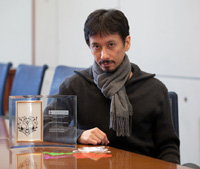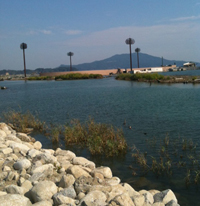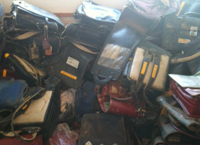

Delivering Hope
Delivering Hope in the Wake of Disaster
Dr. Masaaki Tamura felt helpless last March 11, 2011 when he learned that a devastating earthquake and tsunami had hit northeastern Japan, leaving thousands of his countrymen dead, injured or missing.

Dr. Masaaki Tamura with some of his origami creationsIn addition to being thousands of miles away, Dr. Tamura, a research fellow at Einstein, didn't see how his skills could help. "I was shocked and wanted to do something for the victims, but I'm an obstetrician/gynecologist, not an emergency room doctor," he explained.
At the time, Dr. Tamura did what he could from afar. A gifted origami artist, he made paper cranes, which he and some of his Einstein colleagues sold, along with other items, to raise money for the disaster victims. In all, Einstein students and scientists raised more than $6,500 for the Japanese Red Cross.
But Dr. Tamura wanted to do more, so when he spotted a Facebook post from another doctor seeking an obstetrician/gynecologist to volunteer in Japan, he answered immediately, offering his help.
The timing worked out perfectly. In late summer, Dr. Tamura had to return to Japan to extend his U.S. visa. While there, he was able to spend a full week working at a hospital in the small city of Kesennuma, home to 74,000 people, located 300 miles northeast of Tokyo near the epicenter of the quake.

The altered coastline created by the earthquake/tsunami placed this baseball stadium in the sea. Baseball is very popular in Japan.Because the Kesennuma hospital is at the top of a hill, it was spared while other area hospitals were razed. "The area along the seashore is flat," explained Dr. Tamura, "and all the buildings there were destroyed."
As a result, patients poured into the Kesennuma hospital seeking care. From September 6 through September 13, Dr. Tamura handled the midnight shift, performing checkups on 20 to 30 pregnant women each day. In that time he also delivered five babies.
Some of the women were still reeling from the March disaster. One expectant mother was unable to smile even when sonograms taken at 16 weeks' gestation revealed she was going to have a healthy son. "She was suffering from bad memories," said Dr. Tamura. "Two of her other sons, ages 3 and 5, were swept away by the tsunami right in front of her."
Such experiences prompted Dr. Tamura to think more deeply about his chosen career. "I am doing research in gynecologic oncology," he explained. "It is a field in which doctors must sometimes think about life and death at the same time."
But there were many happy and hopeful moments, too. After Dr. Tamura delivered one infant, the mother, although exhausted from labor, did not want to relinquish her child to the midwife who was standing by. "The mother held the baby gently and tightly, and said, ‘Thank you for coming to us," recalled Dr. Tamura. "It was really emotional, and good."

For many families, these children's backpacks represent children who were swept away by the tsunamiDr. Tamura also received gratitude on behalf of the United States for this country's prompt response to the disaster.
"A taxi driver in Kesennuma said he really appreciated the U.S. Navy," Dr. Tamura recalled. In the first weeks after the earthquake and tsunami, it was virtually impossible to access many hard-hit areas by road because so many buildings had collapsed. In response, United States Navy helicopters carried necessities such as blankets, food and water to people who desperately needed them.
Although he is now back in the United States, Kesennuma is still very much on Dr. Tamura's mind - and his agenda. The city lost 16,000 of its residents to the disaster, and although life has returned to normal on the surface, "they still have psychiatric problems, and they need continuous help."
Dr. Tamura and his wife are expecting their first child next spring; even so, he wants to return to Japan in 2012. "I already used some of my sick days for my volunteer work," he said. "But I hope to go back. I want to do as much as I can from now on!"
Posted on: Wednesday, January 4, 2012

Tablet Blog